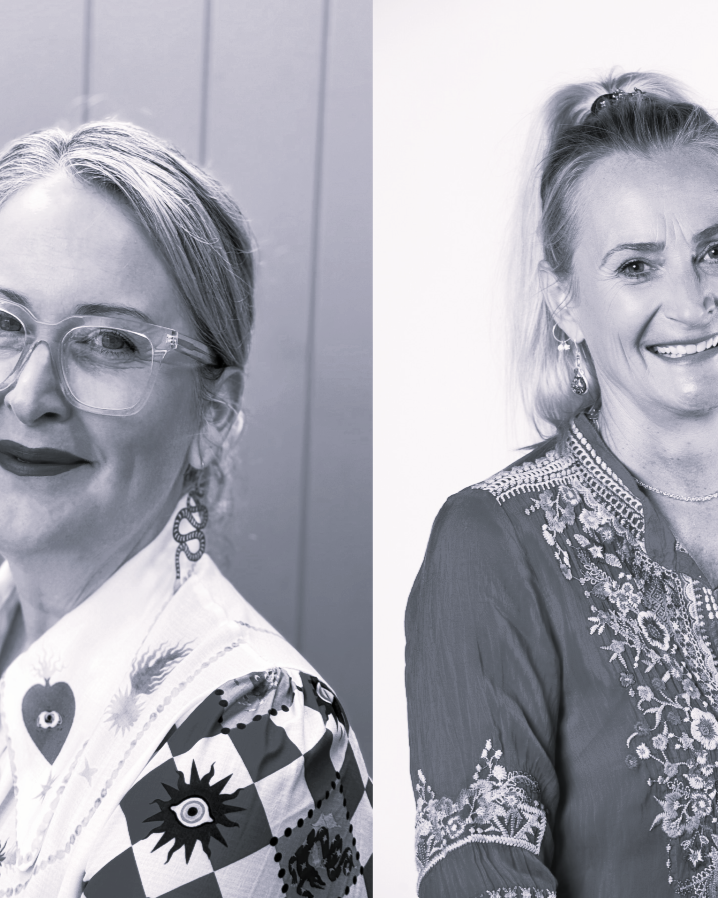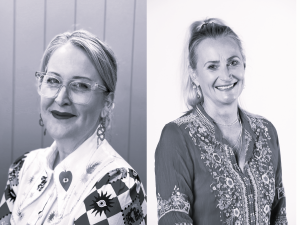
Amanda Stuart & Renee Coombe

Renee Coombe and Amanda Stuart are educators, artists, and passionate advocates for sustainability. Their collaborative sculpture draws inspiration from wallum banksias, pandanus, and black she-oak trees—species uniquely adapted to sandy soils. Renee and Amanda reinterpret the resilient adaptations of these trees in striking, mutated forms, juxtaposing the enduring presence of plastic waste, which can persist for millennia, against nature’s remarkable adaptability and resilience.
Renee’s dedication to addressing waste, particularly microplastics, led her to innovate with waste polyethylene as her primary artistic medium. Amanda, a prolific ceramic artist and environmental conservation advocate, gathers ceramic textures from the coastline and transforms them into a repository of ceramic forms. Together, they create sculptures that serve as both a visual critique of unsustainable consumption and a celebration of the resilience and beauty of the Australian coast line. Their work invites viewers to reconsider humanity’s impact on the environment and embrace sustainable futures.
What Doesn’t Kill You, Mutates and Tries Again
“What Doesn’t Kill You, Mutates and Tries Again” explores the lasting impact of PET plastics through recycled Coke bottles, emphasising single-use consumerism juxtaposed against the resilience of coastal fauna. Inspired by the wallum banksia, black she-oaks, and pandanus trees—plants adapted to Australia’s sandy soils—the work reinterprets their resilience in abstract form. Ceramic rings support the plastic bloom and are imprinted with textures and geographical coordinates of real trees. The sculpture serves as a cautionary reflection on plastic’s environmental toll and a tribute to the resilience of native flora.
What sparked the idea for the work you are exhibiting at SWELL this year?
Our sculpture was born out of a dangerously good combination of champagne, cheese, and two art teachers with a shared concern for the environment. Somewhere between the brie and the bubbles, we hatched a plan to tackle the issue of single-use plastics in a big, sculptural way. It’s our creative toast to the environment, with a serious message wrapped in a bit of playful plotting.
What’s something people might not realise about the process behind your work?
People might not realise that behind the scenes, there have been the occasional moments of self-doubt and sheer terror about finishing on time. Luckily, we’ve perfected a tag-team system; one of us panics while the other offers words of encouragement. We take turns panicking, and the other one tops up the champagne.
What role does location or environment play in your sculptures?
Location is everything for our work. The sculpture has been designed specifically for the foreshore, which is home to the trees that inspired the sculpture: wallum banksia, black she-oaks, and pandanus. These species have evolved to thrive in the harsh, sandy, and salty environment. During SWELL Sculpture Festival, the beach and foreshore become a gallery, giving artists a platform for expression. Currumbin is the perfect place to share our sculpture’s message that reflects on the resilience of coastal plants and the environmental cost of single-use plastics.
What keeps you coming back to sculpture as a form of expression?
For both of us, we prefer sculpture as it allows thinking in three dimensions. Sculpture is tactile and encourages greater audience participation. There is something magical about taking an idea out of your head, wrestling it into a three-dimensional form, and then watching people walk around it, touch it and view it from different angles and in different light.
If you could install your work anywhere in the world, where would it be and why?
We would choose a vibrant, highly frequented coastal destination such as Bali, where the intersection of tourism and natural beauty is most pronounced. Placing the work there would confront visitors directly with the urgent message regarding the impact of single-use plastics and the critical need to respect and preserve marine ecosystems. Our sculpture aims to transform passive observation into active reflection, making environmental responsibility impossible to ignore.
Instagram @tinyshedart @renee_coombe
Website www.tinyshedart.com.au
Come and see for yourself at SWELL Sculpture Festival, Pacific Parade, Currumbin 12th – 21st September.
